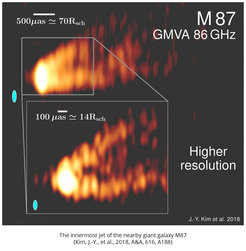Research Highlights
Here we show recent research results from the Radio Astronomy/Very-Long-Baseline Interferometry department.
Helical magnetic fields in the bent jet of the quasar OJ 287
November 12, 2018
Deep in the heart of M 87
September 12, 2018

A new publication led by MPIfR astronomers (see here) presents Global mm-VLBI Array (GMVA) observations at 3.5 mm wavelength of the nearby radio galaxy Messier 87, the central galaxy of the Virgo cluster in a distance of about 50 million light years. The highlight image shows the central region of M 87 at an angular resolution of ~50 μas (7 Schwarzschild radii).
The imaging reveals a parabolically expanding limb-brightened jet which emanates from a resolved VLBI core of about ten Schwarzschild radii in size. The observed brightness and compactness of the central feature suggests magnetic energy dominance at the jet base. Data yield an estimate the diameter of the jet at its base to be about five Schwarzschild radii assuming a self-similar jet structure. This suggests that the sheath of the jet may be anchored in the very inner portion of the accretion disk. Combined images reveal faint emission at the center of the edge-brightened jet on scales smaller than light years.
Charge in the hole
August 12, 2018
Black holes have mass, angular momentum and potentially a charge. While the first two were measured routinely for some time now, constraining a black hole’s charge is more difficult. A comment by Marios Karouzos in "Nature Astronomy" refers to an original paper by MPIfR authors led by Michal Zajaček in MNRAS, proposing an observational way to test limits on the charge of Sgr A*, the black hole at the centre of the Milky Way. The original publication is available here.
Extreme outflows in radio-loud narrow-line Seyfert 1 galaxies
April 17, 2018
A team of astronomers led by Stefanie Komossa from the MPI für Radioastronomie in Bonn has studied four narrow-line Seyfert 1 galaxies and discovered extremely shifted spectral lines in their spectra, which indicate gas flying away from the central regions at speeds as high as 2450 km/s. These galaxies are also emitteres in the radio part of the electromagnetic spectrum. These results suggest that those galaxies are relatively young (in astronomical terms) with lifetimes of the order of magnitude of a million year. The results are published in the present issue of the journal Monthly Notices of the Royal Astronomical Society, to be found here.
New images from the Southern radio sky
February 7, 2018
An international team of astronomers led by C. Müller (Radboud U. & MPI für Radioastronomie) has published new images from a sample of southern blazars in the framework of the TANAMI program. These results are presented in the actual issue of Astronomy & Astrophysics. A powerful array of Southern telescopes located in Australia, Antarctica, Chile, New Zealand, and South Africa was assembled to obtain these unprecedented images. The TANAMI team found that that γ-ray loud sources tend to be more compact on parsec-scales and have higher brightness density in their central regions than γ-ray quiet sources. More information can be found in the original publication here.
Synthetic images from remote galaxies: understanding obscured emission
January 12, 2018
Numerical simulations performed by a team of astronomers in Frankfurt, Bonn, and Valencia led by C.M. Fromm have managed to synthesize the emission from radio objects with an obscuring torus. The numerical code Ratpenat was used to model several jets embedded in various ambient medium and torus configurations and subsequently computed their images, including jet emission and torus absorption. These simulations help understanding the physics of jets and tori, and suggets observational methods such as the core-shift to discern between different physical scenarios in the jet (e.g., if they have equal pressure inside and outside the jet, or if the pressure outside is larger). These results are shown in the present issue of the journal Astronomy & Astrophysics, for more details see here.




